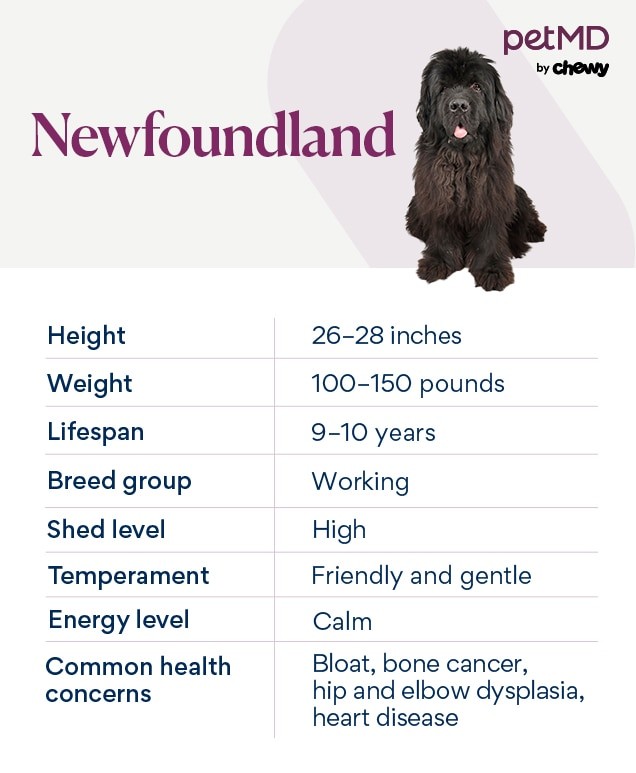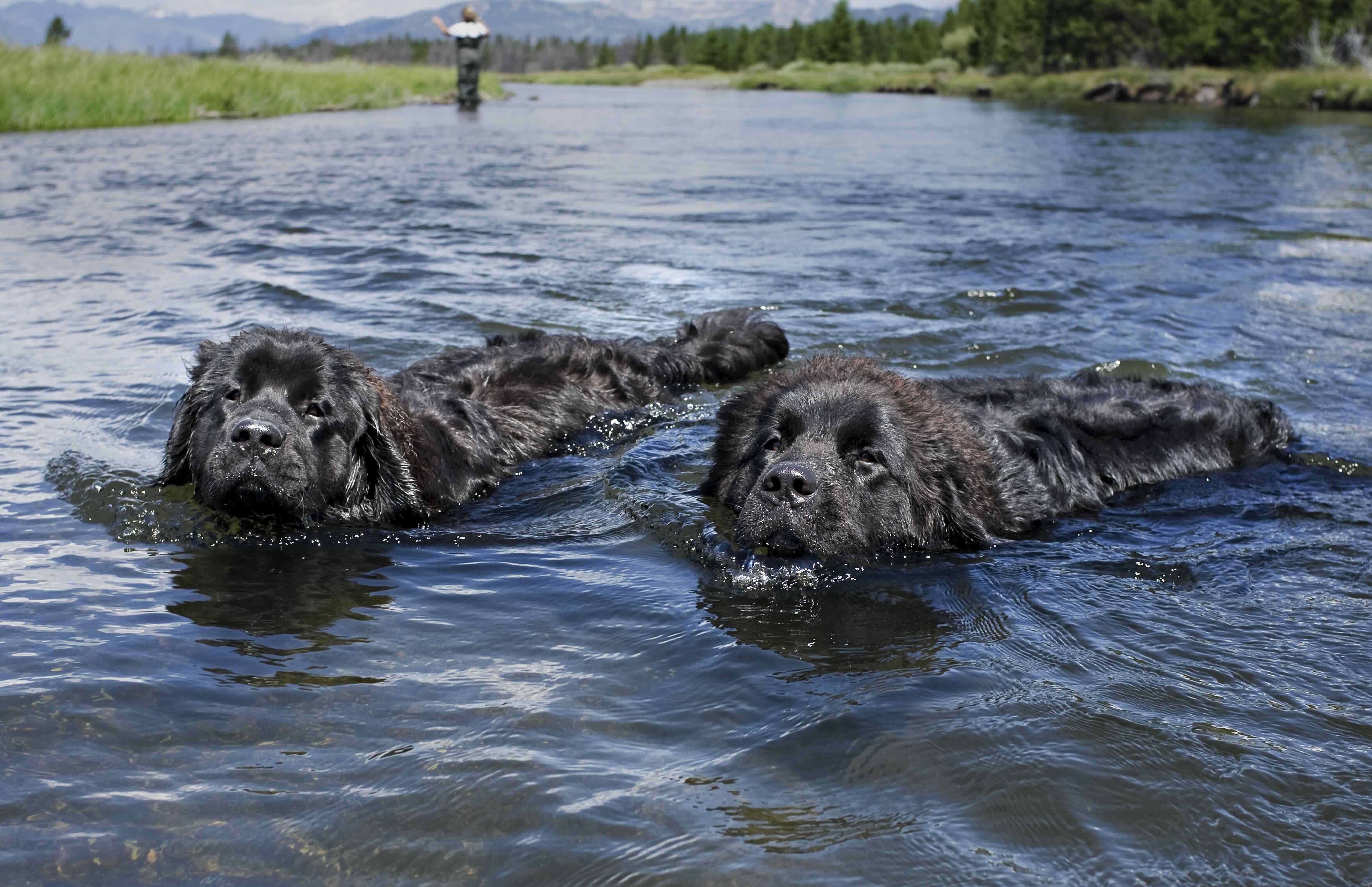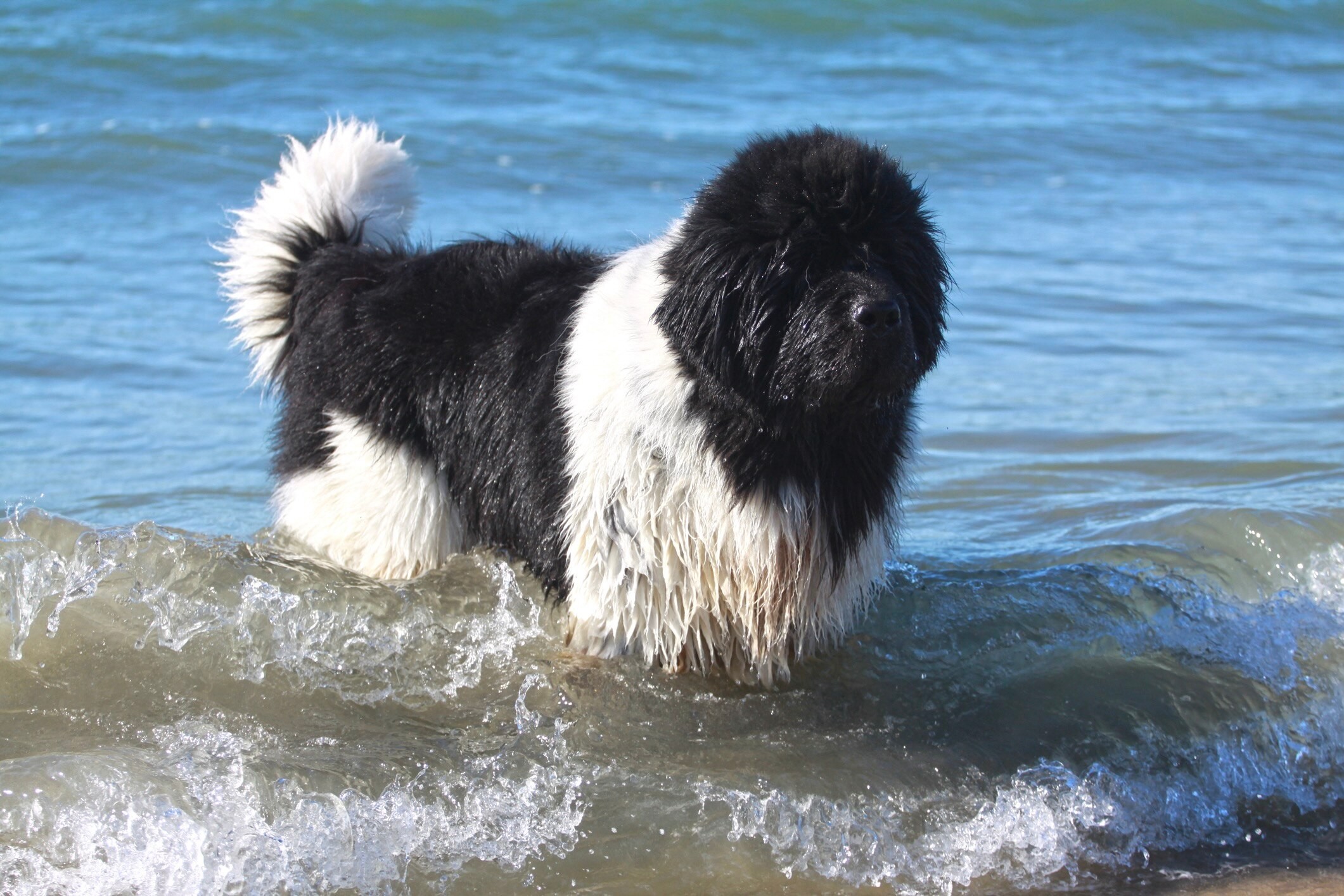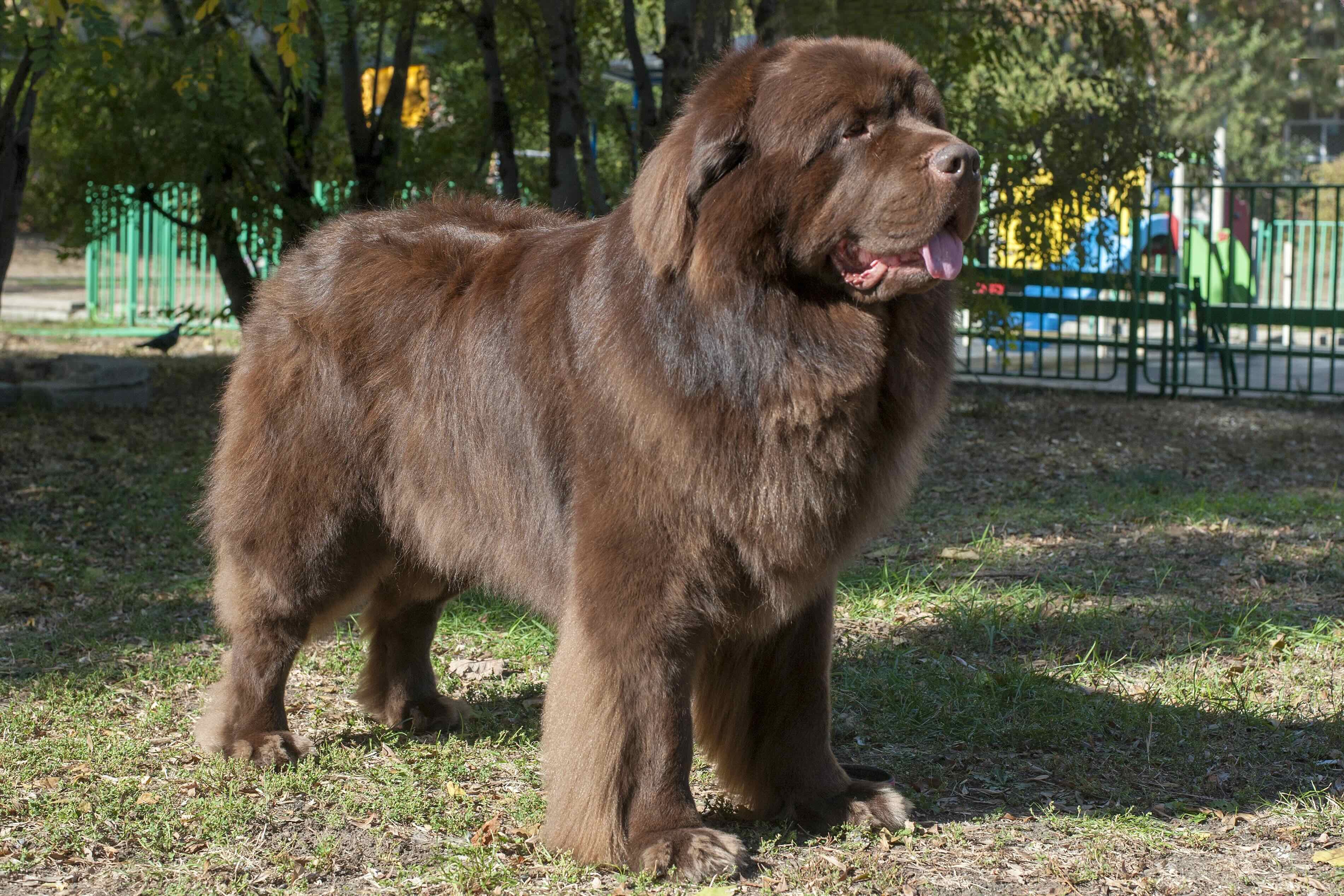Are Newfoundlands Good Pets? Yes, Newfoundlands are wonderful companions known for their gentle nature, loyalty, and affectionate demeanor, making them ideal family pets. At PETS.EDU.VN, we understand the importance of finding the right breed to fit your lifestyle; this guide will dive into everything you need to know about Newfoundlands, ensuring you are well-prepared to welcome one into your home. Discover if a Newfoundland is the right fit for your home and family, exploring their health, training, and care needs.
1. Understanding the Newfoundland Breed
1.1. What Makes Newfoundlands Special?
Newfoundlands, often called “Gentle Giants,” originated in Newfoundland, Canada, where they worked alongside fishermen. According to the American Kennel Club (AKC), Newfoundlands possess incredible strength, intelligence, and a natural swimming ability due to their webbed paws and water-resistant coat. Their primary roles included hauling nets, retrieving objects from the water, and even rescuing people. This working history has shaped them into the loyal and hardworking dogs we know today.
1.2. Physical Characteristics of Newfoundlands
Newfoundlands are imposing dogs. Male Newfoundlands typically weigh between 130 to 150 pounds and stand 28 inches tall, while females weigh 100 to 120 pounds and stand about 26 inches tall, according to the Newfoundland Club of America. They feature a thick, double coat that keeps them warm in cold water but requires regular grooming. Newfoundlands come in several colors, including black, brown, gray, and black and white (Landseer).
1.3. Temperament and Personality
One of the defining traits of Newfoundlands is their temperament. They are known for being exceptionally gentle, patient, and good-natured. Newfoundlands are often referred to as “nanny dogs” because of their protectiveness and patience with children. They typically get along well with other pets, making them a great addition to multi-pet households. However, like all dogs, early socialization is essential. Exposing them to different people, places, and situations from a young age helps ensure they grow into well-adjusted adults.
2. Are Newfoundlands Good Family Pets?
2.1. Newfoundlands and Children
Newfoundlands are famous for their love and patience with children. Their calm and gentle nature makes them excellent companions for kids of all ages. While they are tolerant, it’s always important to supervise interactions between dogs and young children to ensure safety for both. Teaching children how to respectfully interact with dogs is crucial for a harmonious relationship.
2.2. Newfoundlands and Other Pets
Generally, Newfoundlands coexist peacefully with other pets, including dogs and cats. Their laid-back demeanor allows them to integrate well into households with existing animals. Early socialization plays a key role in fostering positive relationships. Introducing your Newfoundland puppy to other pets in a controlled and positive manner can help establish a friendly dynamic.
2.3. Newfoundlands as Guard Dogs
While Newfoundlands are not typically aggressive, their size and protective nature can deter potential intruders. They may bark to alert their owners to the presence of strangers, but they are more likely to offer a friendly greeting than display aggression. Their imposing presence can be a deterrent in itself.
3. What to Consider Before Getting a Newfoundland
3.1. Size and Space Requirements
Newfoundlands are large dogs that require plenty of space to move around comfortably. A spacious home with a yard is ideal, but they can adapt to apartment living if they get sufficient exercise. Ensure they have enough room to stretch out and relax without feeling cramped.
3.2. Exercise Needs
Despite their size, Newfoundlands have moderate exercise needs. Daily walks, play sessions, and occasional swims are sufficient to keep them physically and mentally stimulated. They are not high-energy dogs, but regular activity is important to prevent obesity and maintain their overall health.
3.3. Grooming Requirements
Newfoundlands have a thick double coat that requires regular grooming to prevent matting and excessive shedding. Weekly brushing is essential, and more frequent grooming is needed during shedding season. Regular baths, nail trims, and ear cleaning are also important aspects of their care.
4. Health Issues in Newfoundlands
4.1. Common Health Problems
Like all breeds, Newfoundlands are prone to certain health conditions. Being aware of these potential issues can help you provide the best possible care for your dog. According to research, common health problems in Newfoundlands include:
- Hip and elbow dysplasia
- Gastric dilatation-volvulus (GDV or bloat)
- Heart conditions such as dilated cardiomyopathy (DCM)
- Osteosarcoma (bone cancer)
- Cystinuria
4.2. Hip and Elbow Dysplasia
Hip and elbow dysplasia are common orthopedic conditions in large breeds. Dysplasia occurs when the hip or elbow joint doesn’t develop properly, leading to instability and arthritis. Symptoms include limping, stiffness, and difficulty getting up. Maintaining a healthy weight, providing appropriate exercise, and supplementing with joint support products can help manage these conditions. In severe cases, surgery may be necessary.
4.3. Gastric Dilatation-Volvulus (GDV)
Gastric dilatation-volvulus, or bloat, is a life-threatening condition in which the stomach fills with gas and twists, cutting off blood supply. Deep-chested breeds like Newfoundlands are particularly susceptible. Symptoms include a distended abdomen, non-productive retching, restlessness, and collapse. Immediate veterinary attention is crucial. Preventative measures include feeding multiple small meals, avoiding exercise before and after meals, and considering a prophylactic gastropexy (surgical attachment of the stomach to the abdominal wall).
4.4. Heart Conditions
Dilated cardiomyopathy (DCM) is a heart condition in which the heart muscle becomes thin and weak, leading to decreased cardiac function. Symptoms include lethargy, coughing, difficulty breathing, and collapse. Regular veterinary check-ups and cardiac screening can help detect DCM early. Treatment may include medications to support heart function.
4.5. Osteosarcoma
Osteosarcoma is an aggressive bone cancer that commonly affects large breeds. Symptoms include lameness, swelling, and pain in the affected limb. Diagnosis typically involves X-rays and biopsies. Treatment options include amputation, chemotherapy, and pain management. Early detection and aggressive treatment are essential for improving prognosis.
4.6. Cystinuria
Cystinuria is a hereditary metabolic disorder that results in the formation of cystine stones in the urinary tract. This condition is more prevalent in male Newfoundlands, according to the American Journal of Veterinary Research. Symptoms include straining to urinate, frequent urination, and blood in the urine. Management involves a special diet, medications to dissolve or prevent stone formation, and increased water intake.
4.7. Preventative Measures and Health Testing
Regular veterinary check-ups are crucial for monitoring your Newfoundland’s health and detecting potential problems early. Discuss with your veterinarian about appropriate screening tests for breed-specific health concerns. Responsible breeders perform health testing on their breeding stock to minimize the risk of passing on genetic conditions.
5. Training a Newfoundland
5.1. Obedience Training
Early obedience training is essential for Newfoundlands due to their large size and strength. Start training your Newfoundland puppy as soon as you bring them home. Focus on basic commands such as sit, stay, come, and down. Consistency, patience, and positive reinforcement techniques are key to successful training.
5.2. Socialization
Proper socialization is crucial for Newfoundlands to ensure they are well-adjusted and confident in different situations. Expose your Newfoundland puppy to a variety of people, places, and experiences from a young age. This includes introducing them to different sights, sounds, smells, and textures. Supervise interactions with other dogs and animals to promote positive relationships.
5.3. Positive Reinforcement Techniques
Newfoundlands respond well to positive reinforcement techniques such as treats, praise, and toys. Avoid using harsh or punitive methods, as these can damage your relationship with your dog and lead to behavioral problems. Focus on rewarding desired behaviors and redirecting unwanted behaviors.
5.4. Addressing Common Behavioral Issues
Newfoundlands are generally well-behaved dogs, but they can exhibit certain behavioral issues if not properly trained and managed. Common issues include pulling on the leash, excessive drooling, and separation anxiety. Early training and socialization can help prevent these problems. Provide plenty of exercise, mental stimulation, and attention to address separation anxiety.
6. Grooming Your Newfoundland
6.1. Brushing and Coat Care
Newfoundlands have a thick double coat that requires regular brushing to prevent matting and excessive shedding. Brush your Newfoundland at least once a week, and more frequently during shedding season. Use a slicker brush and undercoat rake to remove loose hair and prevent mats.
6.2. Bathing
Newfoundlands need to be bathed regularly to keep their coat clean and healthy. Bathe your Newfoundland every month, or as needed. Use a dog-specific shampoo and conditioner to avoid irritating their skin. Rinse thoroughly and dry with a towel or dog dryer.
6.3. Nail Trimming
Regular nail trims are essential to prevent overgrowth and discomfort. Trim your Newfoundland’s nails every two to three weeks, or as needed. Use dog nail clippers or a grinder and be careful not to cut the quick (the blood vessel inside the nail).
6.4. Ear Cleaning
Newfoundlands are prone to ear infections due to their floppy ears. Clean your Newfoundland’s ears weekly with a dog-specific ear cleaner. Gently wipe away any dirt or debris. Consult your veterinarian if you notice any signs of infection, such as redness, discharge, or odor.
6.5. Managing Drool
Newfoundlands are known for their drooling, which can be a downside for some owners. Keep a towel handy to wipe away drool as needed. You can also train your Newfoundland to wear a bib to help contain the mess.
7. Nutritional Needs of Newfoundlands
7.1. Diet Requirements
Newfoundlands need a high-quality diet that meets their specific nutritional needs. Feed your Newfoundland a commercial dog food that is formulated for large breeds. The Association of American Feed Control Officials (AAFCO) provides guidelines for ensuring dog food is nutritionally complete and balanced. Look for a food that lists meat as the primary ingredient and avoid foods with excessive fillers or artificial additives.
7.2. Feeding Schedule
Adult Newfoundlands typically do well with two meals a day. Divide their daily food allowance into two portions and feed them in the morning and evening. Newfoundland puppies may require more frequent meals to support their rapid growth. Consult your veterinarian for guidance on the appropriate feeding schedule for your puppy.
7.3. Portion Control
Controlling your Newfoundland’s portions is essential to prevent obesity, which can exacerbate joint problems and other health issues. Follow the feeding guidelines on the dog food label and adjust as needed based on your dog’s activity level and body condition. Monitor your Newfoundland’s weight regularly and consult your veterinarian if you have any concerns.
7.4. Avoiding Bloat
Newfoundlands are prone to bloat, so take steps to reduce the risk. Feed multiple small meals instead of one large meal. Avoid exercising your Newfoundland an hour before or after eating. Consider using a slow feeder bowl to prevent them from eating too quickly.
7.5. Supplements
Consult your veterinarian about whether your Newfoundland needs any supplements. Joint supplements, such as glucosamine and chondroitin, may be beneficial for supporting joint health. Omega-3 fatty acids can help reduce inflammation and improve coat condition.
8. Newfoundland Rescue and Adoption
8.1. Finding a Newfoundland Rescue Organization
If you’re interested in adopting a Newfoundland, consider contacting a breed-specific rescue organization. The Newfoundland Club of America maintains a list of rescue groups across the country. These organizations specialize in rehoming Newfoundlands in need and can help you find the perfect match for your family.
8.2. Benefits of Adoption
Adopting a Newfoundland can be a rewarding experience. You’ll be giving a deserving dog a second chance at a loving home. Adopted dogs often come with some training and socialization already in place, which can make the transition easier. Adoption fees are typically lower than the cost of purchasing a puppy from a breeder.
8.3. What to Expect When Adopting
When you adopt a Newfoundland, be prepared to provide them with a loving and supportive home. Some adopted dogs may have behavioral or health issues that need to be addressed. Be patient and understanding as they adjust to their new environment. Work with a veterinarian and/or trainer to address any challenges.
9. Newfoundland Puppies
9.1. Finding a Reputable Breeder
If you decide to purchase a Newfoundland puppy, it’s essential to find a reputable breeder. A good breeder will prioritize the health and temperament of their dogs. They will perform health testing on their breeding stock to minimize the risk of passing on genetic conditions. They will also raise their puppies in a loving and stimulating environment.
9.2. Questions to Ask the Breeder
When you visit a breeder, ask them questions about their breeding practices, health testing, and socialization methods. Ask to see the parents of the puppies and observe their temperament and health. A reputable breeder will be transparent and willing to answer all of your questions.
9.3. Early Socialization and Training
Start socializing and training your Newfoundland puppy as soon as you bring them home. Expose them to a variety of people, places, and experiences. Enroll them in obedience classes to teach them basic commands and manners. Early socialization and training can help prevent behavioral problems and ensure they grow into well-adjusted adults.
9.4. Puppy-Proofing Your Home
Before you bring your Newfoundland puppy home, puppy-proof your house. Remove any hazards that could be harmful to them, such as electrical cords, cleaning supplies, and medications. Provide them with plenty of safe and appropriate chew toys. Set up a comfortable and secure space for them to sleep and relax.
10. Newfoundland Activities and Exercise
10.1. Water Activities
Newfoundlands were originally bred to work in the water, so they naturally enjoy swimming. Take your Newfoundland to a lake, river, or beach for a swim. Always supervise them closely and ensure they are wearing a life jacket.
10.2. Hiking and Walking
Newfoundlands enjoy hiking and walking, but avoid strenuous exercise, especially during hot weather. Stick to moderate-intensity activities and provide plenty of water.
10.3. Cart Pulling
Newfoundlands were traditionally used to pull carts and wagons, so they often enjoy this activity. Train your Newfoundland to pull a cart and participate in cart-pulling competitions.
10.4. Therapy Dog Work
Newfoundlands’ gentle and patient nature makes them excellent therapy dogs. Train your Newfoundland to visit hospitals, nursing homes, and schools to provide comfort and companionship to those in need.
10.5. Games and Puzzle Toys
Provide your Newfoundland with plenty of mental stimulation to prevent boredom and behavioral problems. Offer them puzzle toys, such as treat-dispensing balls and interactive games. Play games like fetch and hide-and-seek to keep them engaged and entertained.
11. Newfoundland Lifespan and Care
11.1. Average Lifespan
The average lifespan of a Newfoundland is 9 to 10 years. Providing them with proper care, nutrition, and veterinary attention can help them live a long and healthy life.
11.2. Senior Care
As Newfoundlands age, they may develop age-related health problems, such as arthritis, decreased mobility, and cognitive decline. Adjust their exercise routine and diet to accommodate their changing needs. Provide them with comfortable bedding and assistance with getting around if needed. Regular veterinary check-ups are essential to manage age-related health issues.
11.3. End-of-Life Decisions
Making end-of-life decisions for your Newfoundland can be difficult. Consult with your veterinarian to determine the best course of action. Consider their quality of life and discuss options such as pain management and hospice care.
12. Cost of Owning a Newfoundland
12.1. Initial Costs
The initial cost of owning a Newfoundland includes the purchase price of the puppy or adoption fee, as well as the cost of essential supplies such as a collar, leash, food bowl, and bed. You may also need to factor in the cost of vaccinations, microchipping, and spaying or neutering.
12.2. Ongoing Costs
The ongoing costs of owning a Newfoundland include food, grooming supplies, veterinary care, and toys. You may also need to budget for unexpected expenses such as emergency veterinary visits.
12.3. Ways to Save Money
There are several ways to save money on Newfoundland care. Prepare their food at home using affordable ingredients. Groom them yourself instead of hiring a professional groomer. Shop around for the best prices on pet supplies.
13. Newfoundland Characteristics Table
| Characteristic | Description |
|---|---|
| Size | Large (Males: 130-150 lbs, 28 inches; Females: 100-120 lbs, 26 inches) |
| Temperament | Gentle, patient, loyal, and affectionate. |
| Exercise Needs | Moderate. Daily walks, play sessions, and occasional swims. |
| Grooming Needs | High. Weekly brushing, regular baths, nail trims, and ear cleaning. |
| Common Health Issues | Hip and elbow dysplasia, gastric dilatation-volvulus (GDV), heart conditions (DCM), osteosarcoma, cystinuria. |
| Training | Early obedience training and socialization are essential. |
| Nutritional Needs | High-quality diet formulated for large breeds. |
| Lifespan | 9-10 years |
| Space Requirements | Needs a spacious home or regular access to the outdoors. |
| Good with Children? | Yes, known as “nanny dogs” due to their protectiveness and patience. |
| Good with Other Pets? | Generally, yes, especially with early socialization. |
| Shedding | High, requires regular grooming to manage. |
| Drooling | Known for excessive drooling; owners should be prepared. |
| Activity Level | Moderate; enjoys swimming, hiking, and playing but also content with relaxation. |
| Cost of Ownership | Moderate to high, considering food, grooming, vet care, and potential health issues. |
| Suitability | Best suited for families or individuals with the space and resources to care for a large, gentle breed. |




14. Frequently Asked Questions (FAQs)
14.1. Are Newfoundlands good with kids?
Yes, Newfoundlands are famously gentle and patient with children, earning them the nickname “nanny dogs.”
14.2. How much exercise does a Newfoundland need?
Newfoundlands need moderate exercise, such as daily walks and occasional swims, to stay healthy and happy.
14.3. Do Newfoundlands shed a lot?
Yes, Newfoundlands shed a lot due to their thick double coat, requiring regular grooming to manage shedding.
14.4. Are Newfoundlands easy to train?
Newfoundlands are intelligent and eager to please, making them relatively easy to train with positive reinforcement methods.
14.5. What are the most common health problems in Newfoundlands?
Common health problems include hip and elbow dysplasia, bloat (GDV), heart conditions (DCM), and cystinuria.
14.6. How big do Newfoundlands get?
Male Newfoundlands typically weigh 130-150 lbs and stand 28 inches tall, while females weigh 100-120 lbs and stand 26 inches tall.
14.7. How often should I groom my Newfoundland?
You should brush your Newfoundland at least once a week, and more frequently during shedding season, to prevent matting and remove loose hair.
14.8. Are Newfoundlands good apartment dogs?
Newfoundlands can adapt to apartment living if they get sufficient exercise, but a spacious home with a yard is ideal.
14.9. What should I feed my Newfoundland?
Feed your Newfoundland a high-quality commercial dog food formulated for large breeds.
14.10. Where can I find a Newfoundland rescue?
Contact the Newfoundland Club of America or local animal shelters to find Newfoundland rescue organizations.
15. Conclusion: Are Newfoundlands the Right Pet for You?
Newfoundlands are loving, loyal, and gentle companions that make wonderful family pets. However, they require a significant commitment in terms of space, grooming, training, and healthcare. If you are prepared to meet their needs and can provide them with a loving and supportive home, a Newfoundland may be the perfect addition to your family.
At PETS.EDU.VN, we are dedicated to helping you make informed decisions about pet ownership. We offer a wide range of resources, including breed guides, health information, and training tips, to help you provide the best possible care for your furry friends. Visit our website at PETS.EDU.VN or contact us at 789 Paw Lane, Petville, CA 91234, United States or Whatsapp: +1 555-987-6543 for more information. We’re here to support you every step of the way. Consider factors like grooming, space requirements, and potential health issues to ensure a harmonious match. Explore pets.edu.vn today for more valuable insights on pet care and breed-specific information, and create a loving home for your future companion.